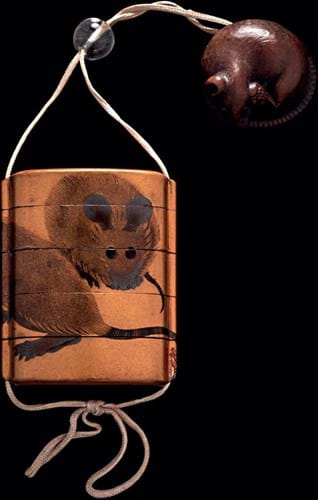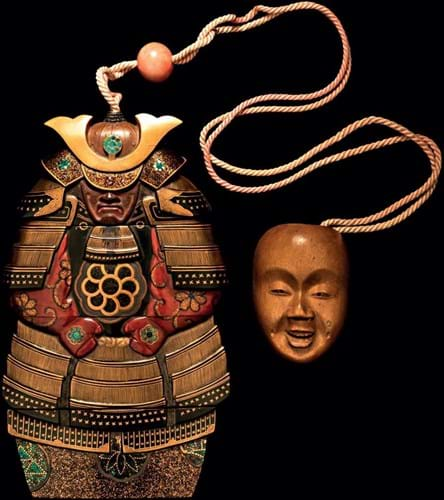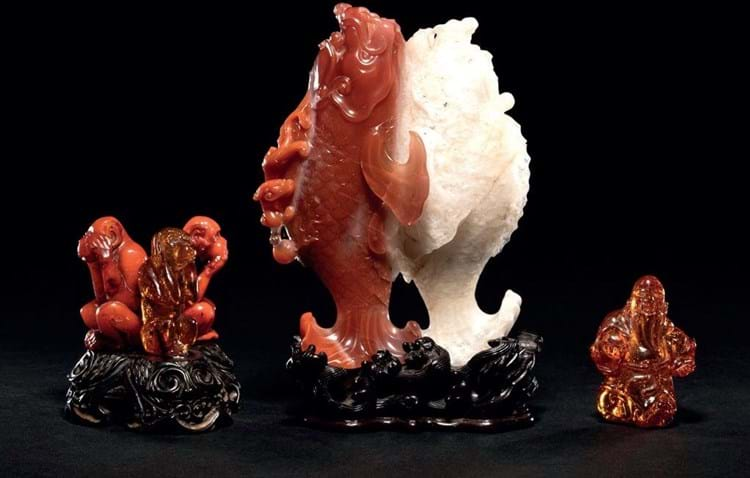
The bi-coloured agate double fish carving offered with two amber groups that led Hindman’s sale of items from the Strong National Museum of Play at $50,000 (£38,460).
These included Chicago where Hindman (25/20/12% buyer’s premium) held a three-day series on March 25, 28 and 29 (plus an online offering) having previewed highlights from the series in the Big Apple during Asia week.
The March 28 auction was a single-owner event, a 350- lot selection of items from the Strong National Museum of Play in Rochester, New York. This museum grew out of the collection of its founder Margaret Woodbury Strong (1897-1969). Her parents had business interests and investments that enabled the family to travel and collect around the globe visiting Shanghai, Hong Kong, Guandong and Japan.
Strong herself collected across a diverse range, assembling tens of thousands of objects with a particular interest in toys and dolls. Her mother Alice was interested in Chinese and Japanese artefacts and the items in Hindman’s sale were mostly composed of her Asian works which fall outside the museum’s focus on the history of play and were being deaccessioned.
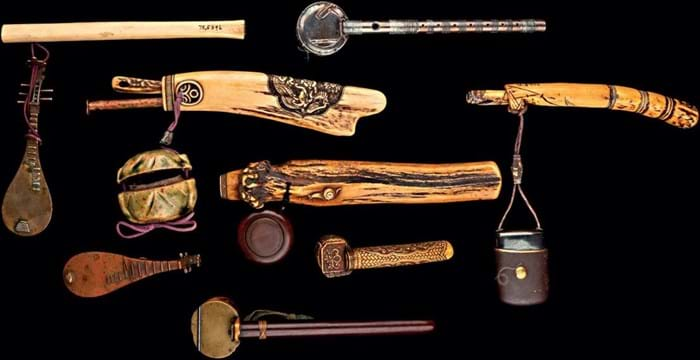
Alice Motley Woodbury assembled a large collection of yatate or portable writing sets made to contain the ink and brush and a sizeable number were included in Hindman’s sale. They were offered in lots containing multiple sets. Pictured here are a group lot of seven dated to the 19th century: five in carved bone; one silver and one bronze, the longest measuring 8¾in (22.5cm), together with an ink reservoir shaped as a biwa or stringed instrument. They sold at Hindman for a multiple of the $600-800 guide, $4750 ($3653).
Carvings go swimmingly
The highest price of the auction was paid for a group lot of Chinese carvings comprising a 6in (15cm) high two-colour agate double fish dated to the 18th century (with some minor losses to the fish fins), set on a hardwood stand plus two smaller amber groups featuring three monkeys and a single figure of an immortal. These sold for $50,000 (£38,460).
The Woodbury Strong Japanese artefacts included examples of inro – the small multi-compartmented cases that were suspended from the sash of a kimono – and netsuke (wooden toggles that secured the inro cord to the sash), both of which were developed into sophisticated, often ingenious, art forms by Japanese craftsmen in the Edo and Meiji eras.
A sizeable group of yatate (writing instruments), of which Alice was an avid enthusiast, was also on offer, and metalware and ceramics featured too.
Demand was particularly keen for some of the inro. Selling for $32,500 (£25,000), against a $1500-2500 estimate, was a 2¾in (7cm) gold lacquer four case inro dated to the Edo period/19th century.
This was decorated in relief with two mice on a gold ground with a black lacquer interior and accompanied by a crystal ojime (bead) and a netsuke carved in the form of a mouse. The inro was signed Shiomi Masanari, in red lacquer. Masanari (mid-17th century to 1722) was a talented painter and lacquer artist who founded a family of lacquer craftsmen with successive generations using his name.
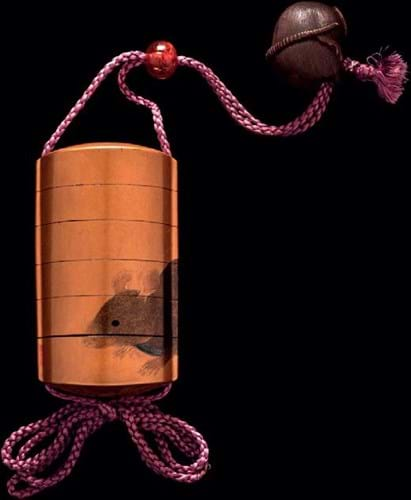
A five-case gold inro signed Shiomi Masanari decorated with a large mouse – $7500 (£5770) at Hindman.
A second slightly larger, 3½in (9cm) five-case gold ground inro, also signed Shiomi Masanari and decorated with a single large mouse with a male figure seated on its back, was dated to the Edo period/18th century. It had a nashiji lacquer interior, an ojime formed of amber and a wooden mouse-shaped netsuke signed Masanao. This sold for $7500 (£5770) against a guide of $1000-2000.
A very distinctive and unusual 6in (15cm) three-case inro shaped as a suit of samurai armour on an armour box decorated with flowerheads was another top-priced example.
This was signed Shokasai, dated to the 19th century and was decorated in detail using a variety of techniques including shell inlay, gold flecking (nashiji) and relief. The inro was in good condition, free from defects and major lacquer loss. It came with a coral ojime and a netsuke formed as a mask and sold for a mid-estimate $13,000 (£10,000).
Other sought-after inro included an unsigned four-case 3in (7.5cm) example with a black ground decorated with a figure of the buddhist monk Daruma seated under autumn leaves to one side and a fly whisk to the other that proved much more popular than the $600-800 guide, selling for $3500 (£2690).
A four-case 3½in (9cm) 19th century inro decorated in gold and brown lacquer with a design of a bird flying among bamboo with a colourful shell diaper patterned base, signed Koma Koryu saku, that had been guided at $1500-2500, ended up selling for $5000 (£3845).
Netsuke selection
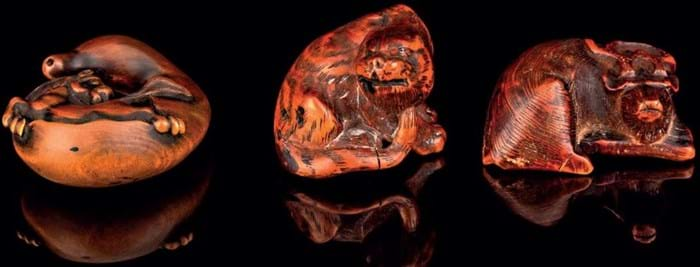
Group of three carved boxwood animal netsuke, one signed Toyomasa, another signed Masanao – $7000 (£5385) at Hindman.
The netsuke in the sale were offered in group lots containing several examples and most sold for three-figure prices.
One notable exception was a lot containing three examples carved from boxwood: one formed as a gourd opening to reveal a horse and signed Toyomasa, another signed Masanao carved as a seated tiger and a third unsigned formed as a recumbent stag. Bidding on these easily outpaced their modest $700-900 estimate, going to $7000 (£5385).
Another was a group of four tall figural boxwood netsuke, the largest 4in (9.2cm) high, dated to the 19th century. Two of them were carved as dancers, the third as a monkey trainer signed Tomochika and the fourth representing the demon vanquisher Shoki with an oni seated on his hat. These doubled the $800- 1200 guide to take $2000 (£1540).
£1 = $1.30


